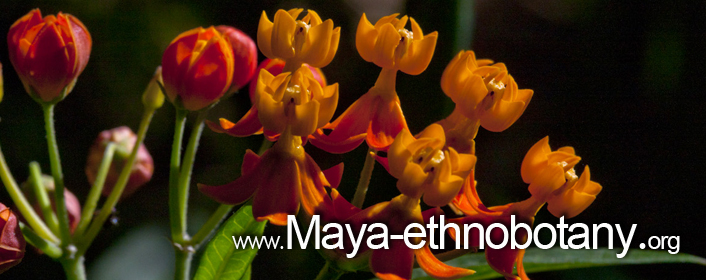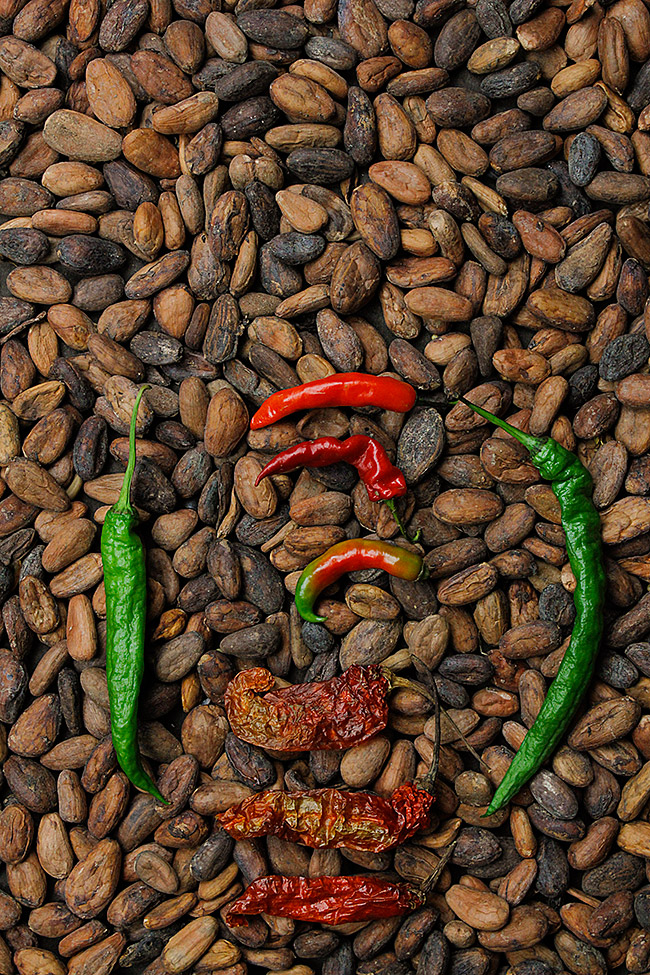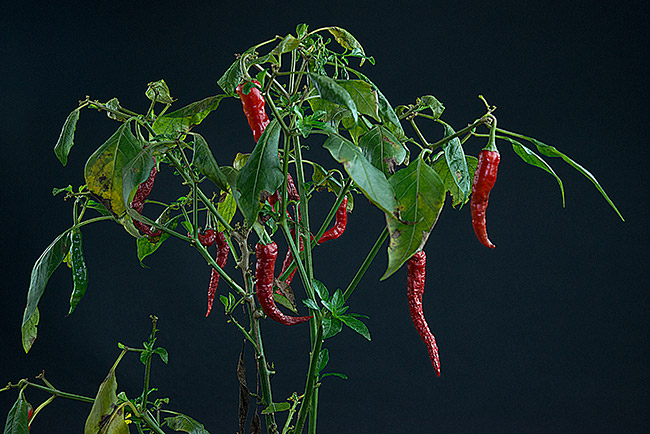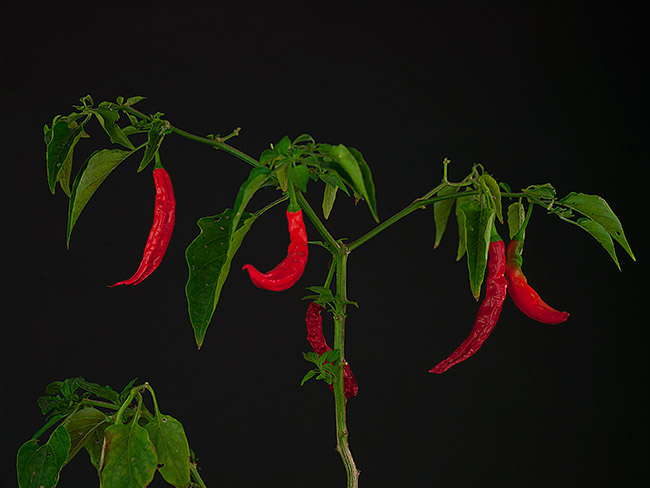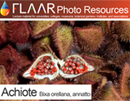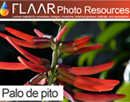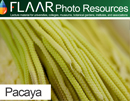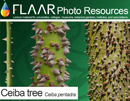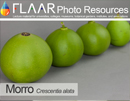When time and funding permit, each flower (each plant species) will have its own page, and its own PDF, and eventually its own PPT so that professors and students have plenty of material on Guatemala (and Honduras, etc) to study.
Heliconia adflexa, Coban, Guatemala, Hotel Monja Blanca, FLAAR, by Nicholas Hellmuth
This space is for flowers
we have recently found and photographed.
|
| Share
|
| Chile peppers were used in cacao (cocoa, chocolate) drinks by Maya of Guatemala but also by Aztec of Mexico? |
|
Books on chile peppers of Mexico (of the Aztec) do not list Chile chocolate In mid August 2014 I was in Mexico City to search for books on plants of Mexico, to aid my research on ethnobotany of Mesoamerica. I found two publications focused on chile of Mexico. Since I am interested in chile chocolate, I bought both publications and assumed I would find chile chocolate inside. But there was no mention of cacao, and no listing for Chile chocolate in these two Mexican publications. Yet chile chocolate is found in most village markets in many areas of Guatemala, especially in Alta Verapaz area. The absence of chile chocolate from two Mexican publications and the presence of chile chocolate in Guatemala raised the question of whether chile chocolate is more a Maya and a Guatemalan variety, and simply not an Aztec variety. Even the Betty Crocker web site uses ancho chile pepper powder. Or, perhaps there are similar chiles in Mexico, but they simply have different names? A company named Kakawa Chocolates uses Ancho Chili and Tree Chili (but the photos they show of their tree chili are very different in size, shape, and color than chile chocolate of Alta Verapaz). One web site at least shows a chile of the correct size, shape, and color as real Chile chocolate: http://wildgreensandsardines.blogspot.mx/2013/01/mayan-chile-chocolate-elixir.html. But they list the following varieties:
I raise this question (whether in Mexico there is the same variety as chile chocolate in Guatemala, but simply with a different name), and hope that ethnobotanists in Mexico and specialists in plants and foods of Mexico can answer this question. I have checked book after book after book on “Chocolates of the entire world…” and almost none of them discuss Guatemala at all. Not one mentions chile chocolate (but several show chocolate colored bell peppers of Mexico). We have a separate web page on books and articles on chile in general. Almost no book on chiles of the world has any mention of chile chocolate of Guatemala whatsoever. What Mexican chiles are comparable size and shape as Chile chocolate in Guatemala? “Chile chocolate” in Guatemala, is not merely any chile used with chocolate. Chile chocolate is a specific variety, size, shape, and taste (rather hot). We spent several years tracking down this chile until we understood how chiles were classified in local villages in Guatemala. Now we have raised chile chocolate for two years. So we have a tad of familiarity with this kind of chile. In the book, El placer del Chile (Long 1998:16 and 17) there are two lists of chiles; chile chocolate is missing from both. There are no illustrations of each variety. The Mexican chiles are the ones that show similar characteristics as Guatemalan chile chocolate. Chile Chocolate Recipes Because most people drink “milk chocolate” or eat “chocolate bars” or other typical sugar-flavored chocolate candy, when we hear about chilli-flavored cacao, I definitely remember it. Over the many decades that I have studied Mesoamerica, I would say that the two things I remember about pre-Columbian cacao is coloring it red with achiote (annatto, Bixa orellana) and flavoring it with chile. Achiote is one of the most commonly mentioned plants when you study the Q’eqchi Mayan people of Alta Verapaz. It is unlikely that the Aztec or the Maya made chocolate brownies or chocolate cakes; most of their cacao was as a beverage. More research is needed on “chile chocolate” of Guatemala (and Mexico!) I need to find conquest-period documentation that the Aztec mixed chile with their cacao. Next step is to understand why the word “chile chocolate” only exists (or only is really common) in Guatemala. If the Aztec consistently drank chile-flavored cacao, why is this not common in Mexico still today. Oaxaca is culturally distinct (and geographically), so chile flavored cacao in Oaxaca is not proof of chile flavored cacao among the Aztec. The other potential source of confusion is mole, which is very Mexican (even if not prehispanic). So even if mole is a chile-chocolate concoction, this is very different. For more images of chile chocolate of Guatemala we have an additional page. Here is the link to our other page on chile chocolate.
First posted Aug. 29, 2014 |
Parque Nacional Yaxha, Nakum and Naranjo
Carnivorous Plants
Plants of Municipio de Livingston, Izabal
- Acrostichum danaeifolium, giant leather ferns
- Bellucia Pentamera
- Bibliography on Grias cauliflora
- Bibliography on Licania platypus
- Bibliography on Mangle negro (Avicennia germinans) L.
- Bibliography on Montriacardia arborescens
- Bibliography on Typha domingensis and Thypha latifolia
- Conocarpus erectus, white mangrove
- Edible Wetlands Plants, Hotel Tortugal
- Heliconia latispatha
- Heliconia wagneriana
- Manicaria saccifera Confra palm
- Neotropical trees of Guatemala need protection
- Nymphoides indica, waterlily flowers
- Pachira aquatica, zapoton
- Bibliography on Pithecellobium Mart., Neotropical trees of Mesoamerica
Ecosystems, Wetlands Aquatic Plants
Smartphone Camera Reviews
Bushes and small trees
Fungi and Lichens
Orchids
- Bibliography Bletia purpurea, aquatic orchid
- Bibliography, Epidendrum radicans
- Bibliography on Habenaria Orchids from Yaxha
- Bibliography, Lycaste virginalis var. alba.
- Bibliography, Macroclinium bicolor
- Bibliography, Prosthechea cochleata
- Bibliography Sobralia macrantha, Lirio de San Juan
- Bibliography, Sobralia xantholeuca
- Bibliography on Terrestrial shade orchids from Guatemala
- Bibliography on Terrestrial sunny orchids from Guatemala
Botanical Terms
Maya and Aztec flavorings for cacao, cocoa, chocolate
- Achiote, Bixa orellana
- Bibliography on Achiote, Bixa orellana
- Bibliography on Esquisúchil, Bourreria huanita
- Bourreria huanita
- Cassia grandis, bucut
- Chile Chocolate
- Chile Chocolate (Capsicum annuum var accuminatum)
- Chiranthodendron pentadactylon
- Cymbopetalum penduliflorum
- Guazuma ulmifolia
- Haematoxylum brasiletto
- Piper auritum, hoja santa
- Piper species
- Quararibea funebris
- Sterculia apetala, castaño
- Tagetes sp., Marigold
- Talauma, a variant of Magnolia
- Vanilla orchid
- Virola and nutmeg
Cacao, cocoa, chocolate
Consulting cacao & Theobroma species
Tobacco Ingredients of Aztec & Maya
Trees of Mesoamerica
- Bibliography on Acacia dolichostachya, Wild tamarind
- Bibliography, Bellucia costaricensis
- Bibliography, Bucida buceras
- Bibliography on Coccoloba belizensis Standl.
- Bibliography on Cojoba sp. and Cojoba arborea
- Bibliography, Ficus.
- Bibliography on Haematoxylum campechianum and H. brasiletto
- Bibliography on Hibiscus pernambucensis
- Bibliography on Ipomea murucoides
- Bibliography on Lacmellea standleyi, lechemiel
- Bibliography on Leucaena leucocephala
- Bibliography on mangle rojo (Rhizophora mangle)
- Bibliography on Manzanillo, Alseis yucatanensis Standl.
- Bibliography on Matilisguate, Tabebuia rosea
- Mangrove swamp Trees
- Bibliography on Ruagea insignis
- Bibliography on Pterocarpus officinalis
Bombacaceae, Bombacoideae
Tropical Fruits of the Maya
- Avocado Hass
- Bibliography on Coloc, Talisia floresii
- Bibliography, Dichogamy of avocado species
- Bibliography on Guayo, Talisia olivaeformis
- Bibliography on Laetia thamnia, Bakelac
- Bibliography on Maracuyá, Passiflora quadrangularis L.
- Bibliography on Punica granatum L., Granada
- Cashew
- Cuajilote, Parmentiera aculeata
- Granada
- Guanabas and Annonas
- Guava, Guayaba, Psidium guajava L
- Introduction to Papaya
- Nance a fruit of prehispanic Guatemala
- Passion flowers and fruits
- Passion flower, giant fruit
- Talisia floresii, Sapindaceae
- Carica Papaya Bibliography
Tropical Nuts
Spices, condiments, food coloring
Medicinal Plants
- Aristolochia, The largest flower in Guatemala, Bibliography
- Asclepias curassavica, bibliography
- Bibliography on Ciricote, Cordia dodecandra
- Bibliography on Contrahierba, Dorstenia contrajerva
- Bibliography on Falso hibisco, Malvaviscus arboreus
- Bibliography on Huele de noche, Cestrum nocturnum
- Bibliography on Lirio araña, Hymenocallis littoralis
- Bibliography on Roble Prieto, Ehretia tinifolia
- Bibliography, Tithonia diversifolia
- Canak
- Calliandra general info
- Guava, Guayaba
- Magnolia and Taluma
- Mayan medicinal plants
- Piper
- Tecomasuche, Coclospermum vitifolium
- Bibliography on Sufricay, Malmea depressa
- Bibliography on Wigandia urens
Underutilized edible plants
Edible Plants of the Mayan World
- Acacia, subin, bullhorn acacia
- Bibliography, Annona muricata
- Bibliography, Annona purpurea
- Bibliography, Annona reticulata
- Bibliography on Chipilín, Crotalaria longirostrata
- Bibliography on Chirimoya, Annona squamosa
- Bernoullia flammea
- Canna indica, tamale wrap
- Cuchamper, Gonolobus
- Guava, Guayaba
- Bibliography, Gonobolus sp.
- Bibliography, Parmentiera aculeata
- Pacaya palm Chamaedorea tepejilote
- Split leaf philodendron, Monstera deliciosa
Plants and trees used to produce incense
Utilitarian Plants
- Bibliography, Acacia farnesiana
- Bibliography on Aechmea bromeliifolia
- Bibliography on Agave americana
- Bibliography, native Agave species from Guatemala
- Bibliography on Anthurium crassinervium (Jacq.) Schott
- Bibliography on Balsa, Ochroma pyramidale
- Bibliography on Bamboo, Guadua longifolia (E.Fourn) R.W.Pohl
- Bibliography, Crescentia alata
- Bibliography, Crescentia cujete
- Bibliography on Hule, Castilla elastica
- Blepharidium guatemalense, irayol blanco
- Crescentia alata, Crescentia cujete
- Tecomasuche, Coclospermum vitifolium
- Bibliography on Coxte, Colubrina arborescens
- Bibliography on Madre cacao, Gliricidia sepium
- Bibliography on Tillandsia usneoides
